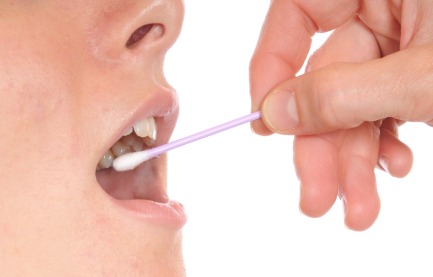

Collecting samples for DNA testing and paternity testing is today done using mouth swabs and exfoliated cheek cells.
Collecting DNA samples for a DNA test
DNA testing is the standard means of determining whether people are biologically related. It is in fact carried out between alleged relatives as well as between parents and their children (such as happens in paternity tests). DNA testing can only be carried out if a DNA sample is available from the people involved in the test. If any of the people who need to be sampled are not available (perhaps deceased) other options will need to be considered.
DNA testing methods: RFLP & PCR
In this day and age what has hugely impacted DNA testing is the actual method of DNA analysis. In the 1980s any form of genetic analysis required very large volumes of DNA as the main method for analysis used: Restricted Fragment Length Polymorphism (RFLP) was only viable if scientists had access to large samples of DNA. RFLP thus also made it difficult for crime cases to be solved unless investigation of the crime scene by forensic experts yielded large blood splatter or several hairs. This method of analysis is not effective if DNA samples are small or degraded (by for example, temperature or chemical substances). Luckily, another method of DNA analysis has evolved, known as PCR (Polymerase Chain Reaction). This method of analysis makes it possible to work with minute, old and even degraded quantities of DNA. It is moreover, more cost effective and less time consuming than RFLP. PCR has made DNA testing available to the world: now online DNA testing companies such as EasyDNA, International Biosciences and Who’zTheDaddy?™, private clinics and hospitals are all offering direct-to-consumer DNA tests at low prices, using accredited laboratories and in very short timeframes.
How are samples collected for a DNA test?
We have already established that PCR or Polymerase Chain Reaction enables scientists to work with very small quantities of DNA. Thus, whilst in the past a DNA paternity test would have required a medical blood draw for scientists to effectively extract the genetic profile of the alleged father and child using RFLP, today’s polymerase chain reaction makes it possible to provide a DNA sample collected by means of a mouth swab (sometimes also called a buccal swab or an oral swab). An oral mouth swab looks very much like a cotton bud. These swabs can be purchased from any pharmacy although DNA testing companies operating over the internet will provide a home sample collection kit. Collecting DNA with swabs is simple and painless – another reason why their use is always encouraged for a DNA test. Oral swabs (or buccal swabs) need to be rubbed around the inside of mouth, mainly against the inner cheek. The gentle friction created by rubbing the end of the swab against the epithelial membrane of the mouth causes any exfoliated cells to attach themselves to the cotton ended part of the swab. This sampling method does not need any kind of assistance by a healthcare professional or doctor.
Once the swabs have been rubbed inside the mouth for duration of around thirty seconds, they need to be left to air dry for around one hour. The drying time is important because it reduces the chances of any fungal spores germinating on the humid surface of the cotton (the humidity is caused by the presence of saliva). If any spores do germinate they may affect the validity of the sample. Ideally, mouth swabs are then placed into paper envelopes although some companies favor plastic containers. Paper is considered better because it allows some degree of ventilation and moreover, its absorbent properties may dry a damp swab, thereby reducing the chances of any mould growing on it.
Ideally, any DNA test entails providing two mouth swabs for every person. Whilst DNA testing using polymerase chain reaction is extremely efficient even with tiny, degraded samples, there may be cases in which one oral swab does not yield the required genetic markers, perhaps due to the presence of mould or perhaps because the number of exfoliated cheek cells on the swab is too small. In this case, providing a second swab means that laboratory analysts can immediately begin analysis on the second swab provided. Chances of successful DNA extraction from an oral swab are extremely high with a percentage probability of 95% (if all precautions have been followed).
Karl M McDonald is a freelance writer specializing in the field of DNA and genetics, with special focus on legal and ethical aspects of such tests. More articles by the author can be found in various article respositories.